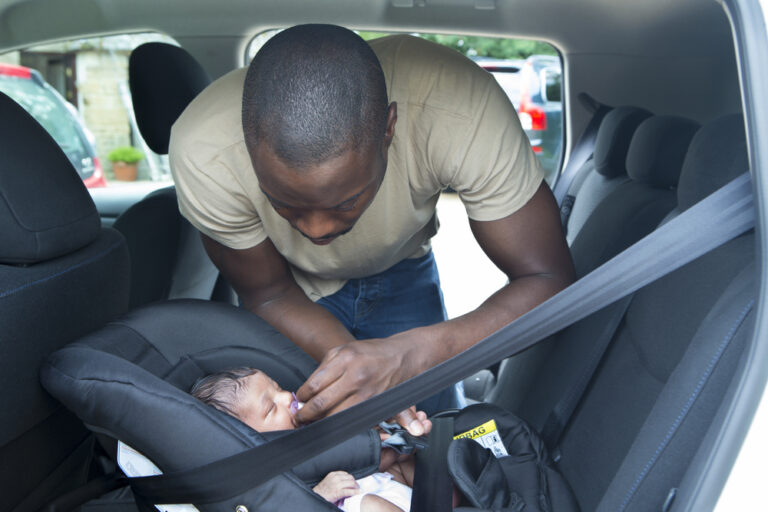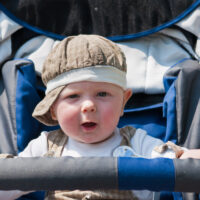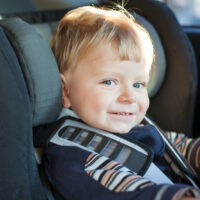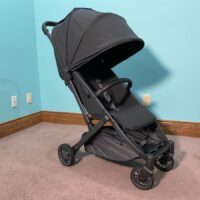Parents find themselves with a lot of questions when it is time to install their baby’s car seat. One of the most common questions is, “Can I install an infant car seat without a base?” Yes, you can install the car seat without the base and it is just as safe as using it with the base. Below, you’ll find out how to install an infant car seat without the base, as well as answers to some of the most common questions.
Do I Need to Know How to Install My Baby’s Car Seat Without the Base?
As long as your baby’s car seat is installed properly, it isn’t more or less safe to install it without the base. The base for a car seat is generally used in vehicles that your baby spends the most time in. For example, it might be in mom or dad’s car depending on who does the most driving.
In most cases, a base is used because it is more convenient. You can install the car seat base using the LATCH or tether system in your car. It’s then anchored in place and you simply have to click the car seat in. To release the car seat, there’s usually a button or lever that you press.
However, moving the base between vehicles can be a hassle. It also isn’t always practical to bring the car seat with you, like when you are traveling in an Uber, taking a cab, or flying on an airplane. Instead, you’ll want to be familiar with how to install a car seat using a vehicle safety belt.
Even if you don’t travel much, you’ll need to know how to install a car seat with your vehicle’s safety belt as your child grows. The LATCH system only works as long as the combined weight of your child and their car seat does not exceed the maximum.
How to Install an Infant Car Seat Without the Base
Reference Your Vehicle Manual
Even though most car seats come with instructions for the install, they only provide generalized steps. To safely install a car seat without a base, you’ll need to be able to lock your vehicle’s seat belt in place. This stops the car seat from sliding around and the belt from loosening while you are driving.
Most vehicle guides will mention a LATCH or tether system that can be used for car seat installation. This information is usually only applicable if you are installing with a car seat base. To install safely without the car seat base, you’ll need to use the vehicle’s safety belt instead.
Installing a Baby Car Seat with a Vehicle Seat Belt
Unless your baby is over the age of 2 or has reached the car seat’s maximum weight or height limit, you should be installing their car seat in rear-facing mode. Most rear-facing car seats have belt guides positioned on either side of your baby’s seat (the exception is European-manufactured seats with belt paths behind the head of the seat like Cybex and Maxi Cosi). If you have a convertible car seat, there may also be belt guides for forward-facing mode. You’ll want to be sure you are following the guides for rear instruction so the car seat is positioned correctly (and safely) on the seat.
You’ll start by threading the bottom portion of your vehicle’s safety belt through the rear-facing belt guides. The lap belt should lie flat across the guide area, without any twists in the belt. You also should not put the shoulder/chest portion of the seat belt through the guides.
Buckle the seat belt once you are sure it’s free of any twists and pull it tight. In some cases, there is a belt lock within the car seat itself. If not, you’ll want to lock the vehicle’s seat belt. Press down on the car seat and pull as tight as you can. Then, lock the belt in place. Usually, you can do this by pulling on the seatbelt with a quick, jerking motion or by pulling it all the way out and letting it tighten again.
Once the belt is in, wiggle the car seat side to side and forward and backward. There shouldn’t be more than one inch of movement in any direction.
Checking the Angle of the Seat
Once the car seat is installed, something else to consider is the angle of the car seat. The optimal angle for a car seat is 30-45 degrees. This keeps your baby’s head tilted back while they are in the car, which is important for keeping their airway open. As your child grows, you’ll likely need to adjust the angle of the car seat so they can sit safely and comfortably.
In some cases, the infant car seat has a level or guide that shows you how the seat should sit against the seat. If the car seat is not sitting properly after installation, take a tightly rolled towel position it under the base of the car seat, down near your baby’s feet. You’ll want to be sure this is rolled tightly so the car seat doesn’t unroll it or loosen as the car seat shifts.
Checking for Proper Installation
Installing your baby’s car seat with a seat belt is really as easy as these steps. Before you are finished, however, you’ll want to be sure the car seat is properly installed.
You’ll also want to be sure the lap belt is in the correct place. Keep in mind that the lap belt should go through the belt guide on the car seat, but the shoulder belt should not. Instead, it should lie flat against the back of your vehicle’s seat once everything is pulled tight.
Finally, be sure the belt and car seat are not going to move as the car seat shifts in any direction. If the seat is loose, you’ll need to tighten the belt and be sure the vehicle’s belt is locked in place.
If you have any questions, one thing you can do is watch videos about car seat installation online. You can find a car seat installation with a seat belt video here, on the National Highway Traffic Safety Administration’s website.
Securing Your Baby in Their Car Seat
In addition to installing the base properly, it’s important that your little one is sitting safely in their car seat. First, you’ll want to be sure the car seat you choose is within your baby’s weight and height range. Preemies and smaller babies may need an infant insert until they are big enough. This is the padding that sits behind your baby, allowing the safety harness to fit them more snugly.
Tightening the Harness
The first thing you’ll want to do is be sure the straps are snug. They should be positioned against your child’s chest and shoulders. You want them tight enough that your baby’s head can’t lay all the way forward because their airway can be blocked if their chin is to their chest. However, they shouldn’t be so tight that they cut into your baby’s skin or make them uncomfortable.
A good rule of thumb is to use the pinch test. Once the harness is tightened, pinch the strap near the shoulders on each side. If you can pinch fabric, you need to tighten the straps. You’ll also want to do this test down near your child’s legs.
Positioning the Chest Clip
It’s very important that your child’s chest clip is positioned on their chest. Your baby’s chest has a rib cage that protects their heart, while their stomach is soft. If the chest clip sits too low, it’s going to damage your baby’s organs in an accident.
Bundle Over the Harness
Even though you want your baby to be warm, you shouldn’t bundle them up inside their car seat. Instead, opt for long-sleeved clothing in the wintertime. A puffy jacket or layers of clothing stops the harness from working properly. You can layer blankets over them as needed so they are warm instead.
FAQs about Installing an Infant Car Seat Without a Base
Is my baby’s car seat safer with the base?
No, your baby’s car seat is not safer with the base. The major benefit of the base is you don’t have to adjust it every single time you put your little one in the car. This lowers the risk of improper installation since the base is already secured and ready to go. Additionally, the base is more convenient for this reason. In most cases, you’ll just place the car seat on the base and push down until you hear the “click” which means it’s secure.
Can I use the seat belt and the LATCH system?
When installing your baby’s car seat, you’ll need to use the seat belt OR the LATCH system. It’s easy to think using both would increase protection. Something to keep in mind, however, is that manufacturers create car seats to work in a very specific way. In a car accident, the force of the impact should be directed away from your baby. This prevents injuries to your baby’s head, neck, and brain. These are severe and may even cause death. While each system gives this protection on its own, using both changes how the safety system works. This means it’s less likely to provide added protection and more likely to cause harm. There also isn’t any evidence that using both increases safety.
Where is the safest place to install my child’s car seat?
The safest place to install your child’s car seat depends on how the car seat is being installed. When installing with the vehicle safety belt, the safest place is the middle seat. If you are using the base with a LATCH system, you’ll only want to use the middle seat if the LATCH system is available.
If you have a vehicle with two rows of passenger seating, you’ll want to install the car seat in the middle seat of the middle row. Even though head-on collisions (which your baby would be closer to in this spot) are most common, side-impact collisions have a greater risk of becoming deadly. Being in the middle protects your child from being close to the impact of the side of your vehicle is hit.
If the middle isn’t an option- the driver’s side is safest. You are more likely to be hit from the side if you are turning left, which causes the other driver to hit the passenger side. Additionally, you’ll be closer to your baby if you put them on your driver’s side. This is beneficial whether you are in an accident or just getting them out of the car.
I’m pregnant. When should I install my baby’s car seat?
You’ll need to know how to install your baby’s infant car seat by the end of your pregnancy. When I was in the hospital, they did a car seat safety check. They checked how the base was installed and how my baby was sitting in the seat.
If you don’t need the space, you can install the base between 35-37 weeks. This will ensure you’re ready before your little one gets here. Additionally, if your baby is born before this, there’s a good chance they’ll need to stay in the hospital until they are able to go home. If you don’t have the space to keep the car seat in the vehicle, you should practice installing the car seat once or twice.
What do I do if I’m not sure the car seat is installed properly?
Car seats only keep your precious cargo safe if they are properly installed. There are many resources for parents that need a little help with car seat installation. In addition to watching videos for car seat installation online, there are car seat inspection stations where you can have a professional check installation (usually for free). You can find out if there is a location near you using this tool from the National Highway Traffic Safety Administration. Some of the most common locations that have certified technicians include fire and police departments, health department buildings, and hospitals. You may also be able to find virtual inspections.
Final Word
Parents have a lot on their plate as they get ready for their new baby. Fortunately, with a little practice, securing your baby’s car seat will become second nature. Hopefully, this guide has helped you learn how to install an infant car seat without a base. Keep in mind there are plenty of resources available. If you do have any questions, chances are someone at the hospital you deliver at will be able to help.






